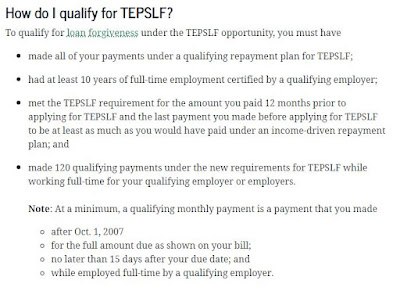Ever since I posted on social media last week that I got student loan forgiveness, I have been inundated by people asking exactly how that happened. I thought it would be best to go through the process here instead of giving piecemeal information to each person who asked. For the record, my loans were forgiven under the Public Service Loan Forgiveness Program. That program states that if you work in a public service job (teachers, librarian, police, firefighter, charitable organization, etc.), then your loan will be forgiven after 120 on-time payments (ten years). It sounds easy but before the new rule change, only a few dozen out of thousands had actually gotten forgiveness through this program. For more details about the new rules, click the link here.
I had been paying student loans off and on since 1993. The balance never went down and when I went back to school, I put those loans into forbearance. All of my loans were different. It was difficult to keep track of. In 2007, legislation passed for the PSLF program and public servants who accumulated ten years of on-time payments while working full-time for a qualifying employer, could start having their loans dismissed beginning in 2017. It seemed like a good deal. Take a lower paying job and get this benefit down the road. Many tried to take advantage but were met with frustration at how the program was actually administered.
Upon moving to Florida in 2016, I consolidated all of my outstanding student loans into a qualifying PSLF loan and enrolled in an income-driven program so that no more than 10% of my disposable income would go toward payment of my student loan. Now that I was in the right program, all I had to do was make on-time payments until 2027 and my loans would be forgiven. The payments that I made before 2016 did not qualify because I did not have the right type of loans or was not in the right repayment program. So from 1993-2016, those payments did not get me any closer to student loan forgiveness. Bummer.
Last month, when changes to this plan went into effect, suddenly the payments that I made from 2007, when the program started, until 2016, when I consolidated into the correct loan payment program, were eligible. FedLoan Servicing, my student loan servicer, sent me an email saying that under the new rules, 82 previously non-qualifying payments (7 years' worth of payments) would now qualify if I could certify employment for those months. Needless to say, I downloaded the form, filled out my portion, and sent it off to the Human Resources Department of my previous school district. When it came back, I uploaded it and waited. Those 82 months, along with the 60 months that I had paid while in the correct repayment program, were many more than the 120 I needed for forgiveness. And so, I waited. Saturday morning, while having coffee on the patio, I opened the email from FedLoan Servicing telling me that my student loans had been forgiven. Wow! I was shocked! I quickly printed out the forms before they could change their minds!
I know that many believe that you can get your loans forgiven just because you're a teacher or work in public service, but it's not that easy. There are two things you MUST do. First, you must make 120 on-time payments. Second, you must consolidate your loans into a PSLF-eligible loan in order to take advantage of forgiveness. Often those eligible loans come with income-driven parameters to keep the payments manageable while making payments. Once you meet those criteria, your loans will be forgiven.
The new Temporary Expanded Public Service Loan Forgiveness allows for previous payments that had not been counted under the old rules to count toward forgiveness. That is the big difference and it really is big. For me, it was 82 payments, or about $40,000 in payments that had not previously counted but did now.
I hope that everyone who works in a public service field and has student loans will take the time to learn about the new rules. These new rules are only good for one calendar year as a way to grant forgiveness to those who should have had it by now but didn't because of the confusion and mismanagement of the program. The rule change has made a huge difference in so many public servants' lives, including my own.

No comments:
Post a Comment